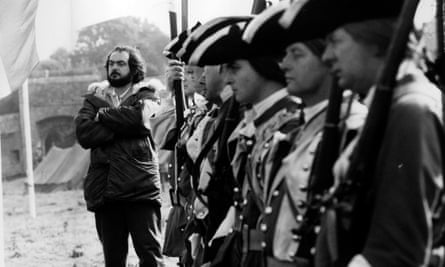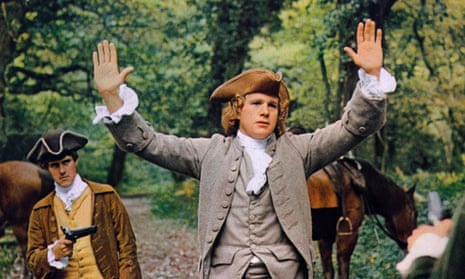Stanley Kubrick was a connoisseur of truly terrible men. In the midst of the Watergate decade, the era of My Lai, Salvador Allende and the Pentagon papers, when heroism was a bargain-basement deal, Kubrick’s heroes upped the ante in the antiheroic. Starting with Sterling Hayden in The Killing and James Mason’s Humbert Humbert in Lolita, Kubrick had long focused on the morally corrupt. A Clockwork Orange’s Alex, The Shining’s ghost-ridden Jack Torrance, even the rationally murderous computer Hal in 2001: A Space Odyssey, all trace a broader cultural shift towards the dishonourable and troubling protagonist. Perhaps the most ambiguous of this crew is charming Barry Lyndon. Played by Love Story’s all-American dreamboat, Ryan O’Neal, Barry is ostensibly the most attractive of all of Kubrick’s protagonists. He is in possession of a few tarnished virtues: undoubted courage; a few moments of fellow-feeling; an immense love for his son. Yet in the course of the film, Barry nevertheless reveals himself to be a trickster, a deceiver, a snob and a bully. The movie enacts a tragedy of success; Barry’s rise is his fall.
Barry Lyndon (1975) stands as a companion piece to two other movies of the era that throw into question the very basis of worldly success – Francis Ford Coppola’s The Godfather and Martin Scorsese’s Raging Bull. It is fully their equal, indeed in one sense superior to them. For only the sunlit castle gardens and painterly interiors of Barry Lyndon succeed in letting us partake of the allure and enthralling charm of a civilisation hollowed out by its discontents. It lets us share the misery of an elegance that promises a satisfaction it cannot provide.
Its hero is born in a colonised Ireland, and the movie delineates a world where we cannot ever feel at home, where displacement is the necessary rule of life. At the mid-70s height of the Troubles, Barry operates as a cuckoo in the nest, undertaking a reverse occupation of England by an Irish outsider. (It has been rumoured that members of the IRA were angry enough with Kubrick for making a film showing British soldiers in Ireland to put him on a hit-list.) Yet Barry cannot find his place in the world, and his attempt to secure permanence always ends in frustration.

Kubrick was never prolific. Between 1956 and 1999 he released a mere 11 films; yet each one is some kind of masterpiece. Barry Lyndon was a three-year project, with a year of preparation, and eight months of shooting. The film itself bears the mark of its meticulous origins; watching it, you feel drawn into a fully realised world. It won four Oscars – all richly deserved. In particular, John Alcott’s cinematography and Ken Adam’s designs are flawless. The supporting cast reveals the great strength of British and Irish character acting then, with Murray Melvin, Gay Hamilton, Patrick Magee, Steven Berkoff, Frank Middlemass and the wonderful Leonard Rossiter. In the early 70s Kubrick doubted if there had ever been a good historical movie. His own costume drama gives us film as an instance of time travel, though his 1770s naturally now look very much like a mirror image of the 70s.
The movie presents us with an object lesson in cynicism, a world where, Barry’s doting mother informs us, “money, well-timed and properly applied, can accomplish anything”. In adapting Thackeray’s 1844 book, Kubrick replaces the novel’s first-person narration with the objectivity of film and a world-weary third-person narration by Michael Hordern. The director had initially wanted to film a version of Vanity Fair, but decided that the scope of that novel was too vast for a feature film. Instead he gave us a male Becky Sharp, a person living by their wits, making their way in the world through trickery and deceit. In the book of Barry Lyndon, Thackeray performs the virtuoso trick of having his hero expose himself, telling us constantly what a fine fellow he is while we note the bully and swindler beneath. In a letter to the actor Fanny Kemble, Edward Fitzgerald, the poet-translator of The Rubáiyát of Omar Khayyám, compared Thackeray’s disheartening analytical dissection with Dickens’ vibrant casualness. He asserted that he “would choose Dickens’ hundred delightful Caricatures rather than Thackeray’s half-dozen terrible Photographs”. Kubrick’s photograph of Barry Lyndon provokes the right kind of Thackerayan disillusionment, drawing us into a mingled condition of attraction and repulsion where human complexity trumps all judgment.
The all-but wordless scene where Barry and Lady Lyndon, who go on to marry, face each other at the gaming table and share their first kiss, stands for me as one of the most superb moments in cinema. Partly it’s the restrained, unhurried step of Schubert’s piano trio, partly it’s Marisa Berenson enigmatic loveliness as Lady Lyndon; it’s the depths hinted at in each surface gesture, how she looks all but ill as she realises she’s falling in love with him, how she distances herself in order to come closer. Most of all, the scene is a candlelit, melancholy masterclass in the art of glances, an object lesson in how film seduces us into looking, and looking again.
Admittedly, Kubrick regards events from a distance, and in memory the film offers a series of tableaux and interiors, people grouped in rooms, or marching ranked in battle formation. Close-ups are few, and when they come their rarity renders them all the more powerful. The film’s reputation for chilliness mistakes irony for a passionless lack of engagement. In fact, desire and, in particular, rage energise the film, bursting apart its studied Enlightenment equilibria. At the heart of the movie is the symmetrical, organised violence of the duel. Barry’s father’s death in a duel kicks off the film. This civilised ritual of aggression chimes with the movie’s stately ordering of profound disorder. Even that astounding scene where Lady Lyndon falls in love with Barry seems structured like a kind of duel, the two facing each other, and Barry’s insistent stare a soft challenge that overwhelms his prey.
Barry is the self as actor, and a poor actor at that. He plays, by turns, a British officer (aptly called Sir Thomas Fakenham), a Hungarian in Prussia, the Chevalier de Balibari, and, for most of the second half of the film, Redmond Barry – his original name – is changed to Barry Lyndon, a pretender hoping to be the aristocrat that he palpably is not. Barry constantly places himself in another man’s shoes, living as a thief of identities.
Such robberies belong to mid-70s Freudianism. Phallic symbols abound: it’s a film where young men tussle over a pencil and an emasculated character loses a foot; when a highwayman robs Barry, he graciously, against standard practice, chooses not to take the young man’s boots. Above all, we watch the palpable oedipal tensions in a young man’s rage at his mother’s second marriage. As far as the ousted son Lord Bullingdon is concerned, he’s trapped in his own version of Hamlet. And Barry himself is on the lookout for father figures – from Captain Grogan to Captain Potzdorf, from the Chevalier de Balibari to Lord Wendover – while being busily intent on displacing another father-figure, the wheelchair-using, possibly syphilitic Lord Lyndon. Desire here can hardly be distinguished from rivalry.

The movie permeates its sarcasm with sadness; it is made for the disabused and defeated. It both allows a tender contempt for Barry’s dewy-eyed, moony despondency, and yet lets us accept that such dejection is real. Barry meanders through a wandering and disconnected life, moving, more at less at random, from one adventure to another, finding, for a time, a provisional security, and always seeking a perpetually elusive freedom, an arrival that never can be reached. The film gives us a perfect realisation of the unrealised, a complete portrait of the incomplete.
Barry Lyndon closes in 1789, a year of revolution. Barry has striven to scratch his way into a society that it turns out is built over an abyss. The great world’s apparent static permanence is a captivating deception. The movie’s epilogue announces that the story’s protagonists were given over to the equality of death 200 years ago. In many ways, the film now also looks like a cinematic work of a glorious ancien régime, a film content to offer its vision at a measured, reflective pace, unashamed of slowness, allowing a space for the necessary boredoms that give salt and savour to the greatest works of art. For all the brightness on screen, its take on the world is a dark one. No one wins here, nothing coheres. And yet, in imprinting its own version of one of Thackeray’s terrible photographs, the movie gives us an unindulgent, clear-eyed and magnificent version of a profoundly compromised human life.

Comments (…)
Sign in or create your Guardian account to join the discussion